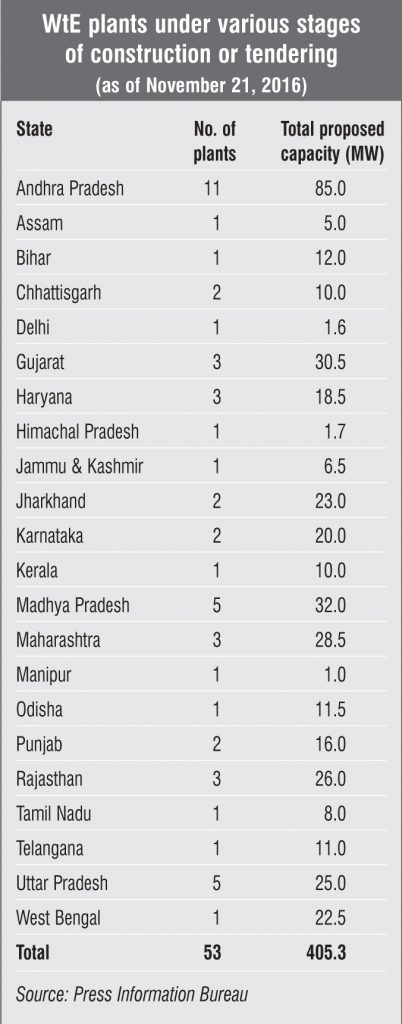
The growth of municipal waste is directly linked to the population and economic progress of a town, city, state or a country. With a population of around 1.34 billion, India generates about 80 million tonnes of waste each year. This is expected to grow up to 430 million tonnes per year by 2050. Of the total waste generated per year, 80 per cent goes into landfills while less than 20 per cent is treated or recycled. Therefore, the existing landfills are reaching their maximum capacity and there is a growing industry consensus that proper waste disposal techniques will be needed in the near future.
Waste-to-energy (WtE) plants have rapidly emerged as an effective solution for waste disposal. According to the Ministry of New and Renewable Energy, India has the potential to generate about 1,700 MW of energy from urban waste including municipal solid waste, sewage and industrial waste. As of June 30, 2017, the total installed capacity of grid-connected and off-grid WtE plants in India stood at 114.08 MW and 73.29 MW respectively. During 2017-18, no grid-connected WtE capacity has been added so far against the target of 10 MW. Meanwhile, only 2.2 MW of capacity has been added to off-grid WtE plants against the 15 MW target.
Key advantages
WtE plants not only provide clean and continuous baseload power, but also address issues concerning the storage and disposal of waste. In addition, in these plants power can be quickly ramped up or down to balance the sudden loss or increase in power and can therefore support renewable energy integration. The technology can also reduce SOx, NOx and greenhouse gas emissions in the atmosphere. Further, logistical issues involved in the transportation of waste to landfill sites which may be located over long distances can be avoided. The expansion of the industry is expected to create job opportunities for both skilled and unskilled labour. To this end, the Council for Skill Development is in the process of formulating an innovative plan to train waste pickers to make handloom artefacts from segregated waste items.
Long-term and improper waste storage in landfills may lead to leakage of harmful elements, which can contaminate the soil and groundwater. This can be easily prevented by converting the waste into energy. According to Walter Howard, chief executive officer, Alter NRG Corp, India is facing a public health problem associated with waste, which can be overcome using the technology available across the world. Therefore, an indirect benefit of WtE generation can be the improvement of lifestyle and eradication of multiple health issues prevalent in communities residing near waste disposal sites.
The by-products from a power generating unit such as oils, gas and solid waste can be sold to industries or consumers, thereby generating additional sources of income for the plant owner. For instance, the plastic waste recovered can be mixed with tar to increase the life of roads or synthesis gas generated in converters can be used to produce electricity or can be refined into other valuable products such as synthetic natural gas, ammonia and ethanol.
Issues and challenges
The implementation of the emerging WtE technology requires proactive government intervention. With the current impetus to achieve solar and wind energy targets, the WtE segment has not received enough policy focus. Although research is being promoted by the government to develop innovative WtE solutions, the implementation of technologies that are available has been rather sluggish.
The segregation of waste continues to be the biggest challenge for large-scale technology adoption. A proper waste management cycle is necessary to derive maximum benefits from the technology. Organisations are also facing a scarcity of funds for pilot projects primarily due to the lack of information regarding the technology and competition from alternative sources of power generation.
Incineration plants are susceptible to backlash from residents and non-governmental organisations in case the air quality in these plant sites deteriorates. Therefore, WtE plants will require stringent air pollution norms and implementation guidelines in order to maintain clean air in areas surrounding the WtE plant given that India is already grappling with the improper adoption of air quality norms for thermal power plants and urban transport.
The way forward
Considering the inherent benefits of the technology, the government can focus on developing WtE to realise its renewable energy targets. The identification of a proper value chain for WtE generation will be extremely important to make the waste management process profitable and self-sustainable.
In a recent move, the Ministry of Environment, Forest and Climate Change directed that activities such as segregation, composting, refuse-derived fuel production and setting up of WtE plants with up to 15 MW of capacity at existing landfill sites do not require green clearance, thus fast-tracking the construction of WtE plants. Several WtE projects have already been tendered. The industry opines that subsidies and active government support will be required for promoting WtE projects till the market evolves and competition drives down costs to make the projects economically viable. To this end, funding mechanisms and regulations should be put in place. Government agencies need to realise that stalling of large-scale WtE projects could prove to be detrimental and large funds need to be diverted for waste management in metro cities. The authorities need to ensure proper formulation and strict execution of policies to support the technology. WtE technology has seen success in multiple countries such as Japan, the US and China as well as in the European Union countries. India can also harness energy from waste, cleaning the country one landfill at a time.





